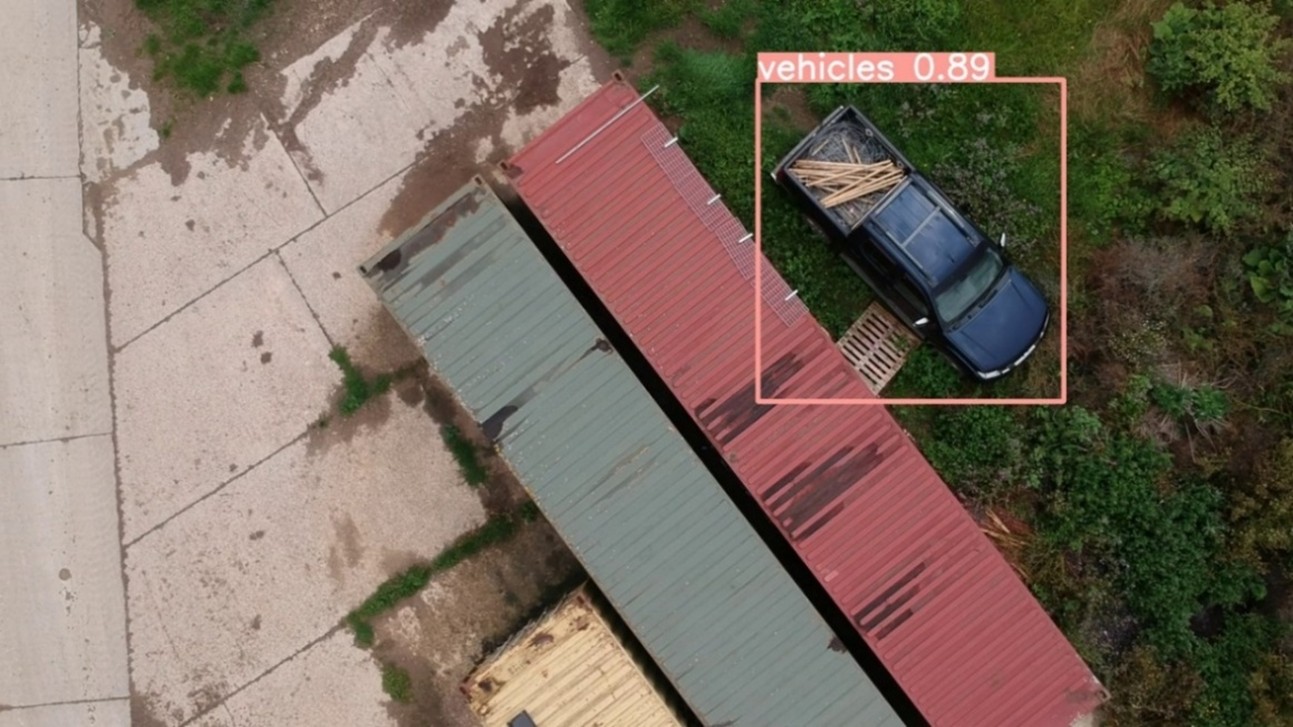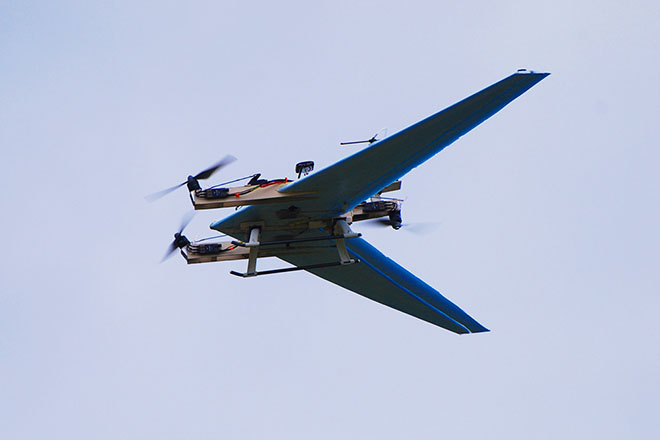
Automatic detection by a UAV of a pre-defined item (here, a vehicle) near some containers. Training using a wide variety of stock images looking at cars from above. The YOLO V8 software, running on an Intel x64 Ultra Compact PC on the UAV, is used to detect and classify pre-defined objects in real time.
There are many military and security applications of a swarm of VTOL capable stealth V Wing UAVs

VTOL = vertical take-off and landing
- Wide area, single pass, covert mapping of a wide area (e.g. 20 UAVs flying line abreast will cover a 1 km wide swathe) using a formation of UAVs
- Use a real time spectrum analyser together with a Radio Direction Finding (RDF) antenna on each UAV to locate and characterise sources of CW and pulsed RF signals from 300 MHz to 6 GHz
- Use thermal imaging cameras on each UAV and difference detection image processing for real time situational awareness in a complex military environment, e.g. camouflaged troops and vehicles
Other military and security applications
Cargo transportation using the Panchito VTOL capable unmanned aircraft
- Stockpile ammunition, food, water and medical supplies at an unattended location for later use by reconnaissance (recce) troops, leaving no tell-tale footprints, or tyre tracks, to the stockpile. The recce troops can also send back captured documents and weapons using the cargo UAVs
- Transport spares for a broken down vehicle in a location that might be difficult to reach
- Cargo transportation using a formation of VTOL UAVs with automatic cargo detachment capability will allow you to transfer huge cargos quickly, even if bridges are destroyed, roads are impassable and / or the destination is in a difficult location, such as in a jungle, or in a combat zone
Radio relay via satcoms terminal on a high flying InView ESM UAV (seen on the front cover)
- Use a lightweight, inexpensive PMR-446 (“Walkie Talkie”) transceiver on the ground to communicate with a PMR-446 transceiver connected to a satcoms terminal on an InView ESM UAV. The satcoms terminal on the UAV will then connect you to Headquarters, regardless of where you are on Earth
- You can use the 2.4GHz Wireless Local Area Network (WLAN) link between your laptop on the ground and the 2.4 GHz wireless modem on the UAV that is connected to the satcoms terminal to provide you with Internet connectivity, and you do not need to carry a satcoms terminal with you
Use the InView ESM UAV in an Airborne Warning And Control System (AWACS) role
- Use the scanning Solid State RADAR mounted in the nose of the InView ESM UAV to detect low flying aircraft and helicopters, and relay that information to the GCS via the satellite communications link, as the InView UAV circles the area of operations for hours on end
- When the InView ESM UAV is flying below 1,000 feet Above Ground Level, the RADAR on the InView ESM UAV will also detect moving of distant vehicles
- Control a high resolution pan, tilt and zoom video camera on the underside of the InView ESM UAV, and relay the imagery to the GCS via the satellite communications link to provide the staff at the GCS with real time situational awareness of what is going on in the region being patrolled by the UAV
Maritime patrol
- Unmanned aircraft equipped with Synthetic Aperture RADAR (SAR – to detect oil slicks) and an Automatic Identification System (AIS – look at the ships with their AIS turned OFF) can be used in maritime patrol applications to detect illegal activities at sea, including illegal fishing, piracy, or emptying of oil tanks at sea

Use of unmanned aircraft to monitor shipping activities and the safety of oil platforms.
Anti-poaching
- Use a formation of UAVs, flying in elliptical flight paths, to detect poaching activities in a game reserve
Border patrol
- Use a Follow - the - Leader formation of unmanned aircraft to provide unbroken monitoring of a porous border, using on-board machine intelligence on each UAV to automatically detect people and vehicles
Modular UAV construction allows the BML unmanned aircraft to be configured to suit any mission
- Ease of transportation of the UAV modules in a van, allowing for assembly at the launch site
- Ease of maintenance of the UAV – just replace a faulty, or damaged, module so the UAV can soon fly again, while the faulty or damaged module can be cost effectively repaired in a local workshop
- Ease of upgrading a module, for example, the autopilot, without incurring a huge expense
- The UAV configuration, for example, the wing span (can be increased to carry extra fuel for long range missions), or the sensor tray, can be changed to suit the mission